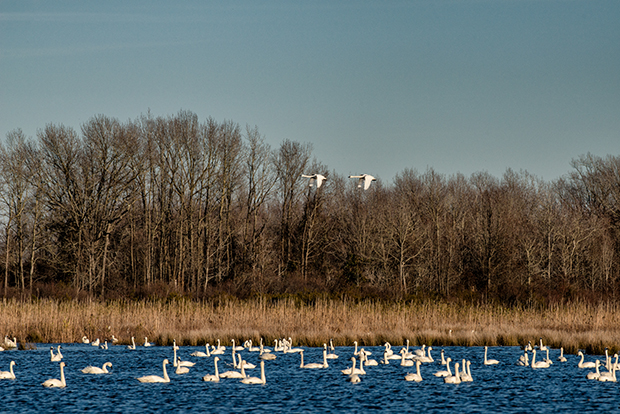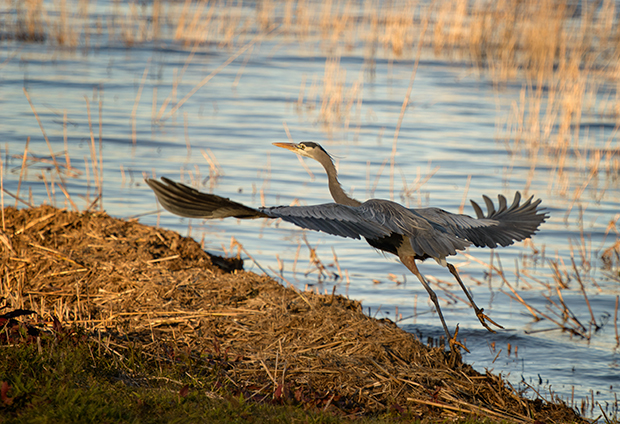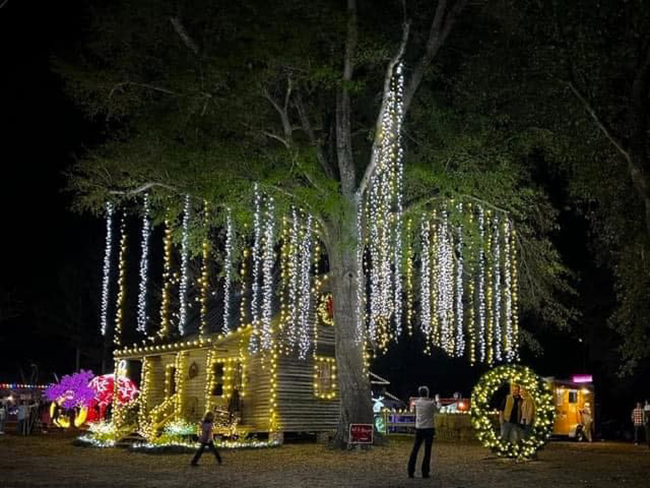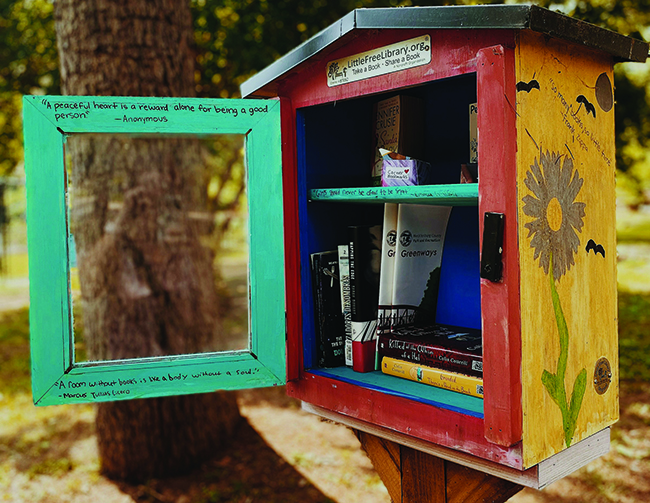Welcoming Our Overwintering Feathered Friends
05 Jan 2022
North Carolina is a destination state for feathered fauna
By Crissy Neville » Photos by Neva Kittrell Scheve

Coastal areas are not known for snow but come winter, a beautiful blanket of white descends on much of the barrier islands and low-lying landscape of The Tarheel State. However, the show is not of the precipitation type, but rather one of anticipation, the kind that results from an event worth waiting for.
Summer brings the beach and bathing suit crowd to the ocean, lake, pond and estuary shores of these remote lands, but the site of downy-white wings beckons other enthusiasts. The time is winter, the place – Northeastern North Carolina. And, the can’t-miss event is the annual overwintering of waterfowl, notably the showy snow geese and tundra swan. Each fall, these birds fly from distances as far away as the Arctic to come here. They coexist with our native shorebirds for a short while, commune, eat, rest after their long journey, and eat some more. It’s a bash that announces the birds are back, and the birders come right along with them.
Notice I did not say birdwatcher. The term of old means you are a casual admirer of our feathered friends but may not know a finch from a sparrow. The term of late, birder, denotes you pursue your passion for finding and identifying birds and do so solo or with a group of friends, i.e., birds of a feather. The real hard-timers are the twitchers, a select sobriquet reserved for those who travel long distances to see a rare bird that would then be ticked or counted on a list — their own life list. The term twitcher originated in the 1950s when it was used to describe the nervous tendencies of British birdwatcher Howard Medhurst. These references relate just to hobbyists, mind you, though pleasure often leads to lifelong professions with this crowd.
According to U.S. state park officials, birding has been burgeoning since the early 20th Century. Even today’s digital age has not stymied enthusiasm but has actually fueled the fire; smartphone apps like Merlin Bird ID, Audubon Birds, iBird Pro, eBird and more pull in a novel audience and newcomers to the game with every new tech advance, making identification and recording of observances as easy as A-B-C. Birding has become the fastest-growing recreational activity among young people in the country.
Here’s another stat: the hobby surged during the pandemic because — guess what — even though we were in lock-down, the birds weren’t.
Of course, like Barbara Mandrell, who crooned, “I was Country when Country wasn’t Cool” in 1981, some of us were “bird nerds” before COVID.

Why birdwatchers get hooked and become birders and beyond is simple; first, birding is an activity anyone can do, regardless of age, gender, ethnicity or physical condition. It is not costly or demanding of particular skills or supplies. To get started, all you need is good eyesight or a nice pair of binoculars. Of course, with time and interest, more gadgets can be added: scopes, field guides and even cameras, especially if you are in the nature niche of the Sandhills Photography Club (SPC). According to SPC President Neva Scheve, nature and wildlife photography is a particular passion of many club members. Club members regularly take winter trips to the Outer Banks region to photograph birds, she said.
In addition to these few optional pieces of equipment, choosing the perfect birding location is the next thing on the list and the best way to enhance your birding experience. SPC members know that is the deal, which brings me back to OBX.
The best winter places to bird in North Carolina are where our Arctic visitors, weary from thousands of miles of travel, can rest and take refuge. And where else would this happen but IN a refuge? Arriving waterfowl find ideal conditions to overwinter on some 10 national wildlife refuges throughout North Carolina’s barrier islands and northern coastal plain, notably the Outer Banks’ Pea Island National Wildlife Refuge on Hatteras Island; and Mattamuskeet National Wildlife Refuge and Pocosin Lakes National Wildlife Refuge, both located on the Albemarle-Pamlico Peninsula. These sites are solid gold on the hit parade that is North Carolina birding. North Carolina is a destination state for feathered fauna, with over 460 species documented to date and over half that number found breeding here.
To see a flock of tundra swan, enormous white plumed, black-billed birds with long, slender necks who fly in a perfect V formation as high as 26,000 feet and then descend to take water, is akin to the most beautiful of ballets; there’s synchrony and sophistication in how they harmoniously move — possessing the sky, En l’air, with the posture of one but the cadence of a choir. Like a troupe of dancers in motion, they fly, rise up, swoop down, soar far, peer hard and tarry only when the performance – or job – is done, finding a habitat and food supply to fit their collective needs.
The tundra, North America’s most prolific swan, is also known as the “whistling swan,” a name given to it by Meriwether Lewis, who heard its characteristic whistling of wind under their wings. They have a little yellow at the base of their black bill, which is one way, along with its slightly smaller size, to identify it from N.C.’s native trumpeter swan. The long-distance travelers breed in the Arctic coastal plain in Canada and then migrate to the U.S. West and East coasts to find food.
According to the North Carolina Wildlife Resources Commission, North Carolina plays a vital role in the yearly cycle of the eastern population of tundra swans, wintering more swans, by far, than any other state on the East Coast. Each fall, approximately 65,000 to 75,000 swans migrate to northeastern North Carolina to benefit from abundant food sources found in lakes, sounds and farms where they source shallow water-plants roots, mussels and clams, and cut-over corn and wheat.
Moving in for the winter along with the tundra swan, another migrator for which North Carolina puts out the welcome mat is the snow goose. This loud, white-and-black bird is now among the most abundant waterfowl in North America. Birders usually hear them before they see them — noisy honking is their signature calling card. Audubon.org calls their song “a high-pitched, barking bow-wow! or howk-howk!”
Snow geese are as close to snow as it gets in Northeastern North Carolina, which registers less than 2 inches of snowfall a year in the coastal regions — and not every year at that. A farm field full of these beauties, typically seen in very large numbers or not at all, may make you believe a blizzard has hit the bullseye. If you see a rare blue head in the flock, it’s the ‘blue goose,’ long considered a separate species and now known as a color morph of the smaller species, the lesser snow goose.
More than 20 species of migrating ducks join our Arctic friends who also make these lands their winter retreats. Other passers-by of the humankind, such as members of the Carolina Bird Club, with Sandhills representation, and the Sandhills Natural History Society, have trekked these territories many times and concur: the biodiversity and helpful habitat of North Carolina’s barrier islands and northern coastal plain make it literally, well, for the birds.













